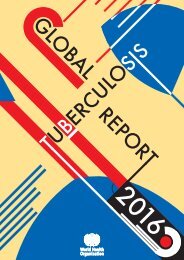patients
DNDi_AR_2015
DNDi_AR_2015
Create successful ePaper yourself
Turn your PDF publications into a flip-book with our unique Google optimized e-Paper software.
STRENGTHENING EXISTING CAPACITIES<br />
Building strong R&D<br />
collaborations to answer the<br />
needs of filariasis <strong>patients</strong><br />
In 2015, DNDi’s filariasis programme<br />
pursued its analysis of filariasis<br />
<strong>patients</strong>’ needs. Clinical expert<br />
meetings held in May and October<br />
resulted in the definition of a Target<br />
Product Profile (TPP) of a new<br />
treatment for onchocerciasis, and<br />
the team visited research centres in<br />
Cameroon to assess possible sites<br />
for clinical studies. The team also<br />
attended two meetings of the African<br />
Programme for Onchocerciasis<br />
Control (APOC), its 40th Technical<br />
Consultative Committee in Burkina<br />
Faso (March) and the APOC closure<br />
meeting at its Joint Action Forum<br />
in Uganda (December).<br />
Building strong R&D partnerships<br />
with disease experts is the first step<br />
towards answering <strong>patients</strong>’ needs<br />
quickly and efficiently. To reach this<br />
common objective, DNDi has started<br />
collaborations in 2015, notably with<br />
the Department of Public Health<br />
of the University Medical Center<br />
of Rotterdam, the Netherlands for<br />
an epidemiological modelling study<br />
on onchocerciasis and lymphatic<br />
filariasis; with CEA/LETI, France and<br />
the Research Foundation in Tropical<br />
Diseases and the Environment,<br />
Cameroon (REFOTDE), for an<br />
optical, non-invasive approach for<br />
clinical studies on drug effectiveness<br />
MISSION OF THE PLATFORMS<br />
for onchocerciasis; with CEA/<br />
LETI, REFOTDE, the Institut de<br />
Recherche pour le Développement<br />
(IRD), France, and the National<br />
Natural History Museum, France<br />
for research on biomarkers and<br />
surrogate endpoints, and has<br />
regular interactions with key<br />
stakeholders in clinical research<br />
for filarial diseases.<br />
• Define <strong>patients</strong>’ needs, taking into consideration the local settings<br />
• Bring together key regional actors in the disease field, namely<br />
representatives of ministries of health, national control programmes,<br />
regulatory authorities, academia, civil society groups, and pharmaceutical<br />
companies, as well as clinicians and health professionals<br />
• Utilize, capitalize upon, and reinforce clinical capacities in endemic<br />
regions, and address infrastructural requirements where necessary<br />
• Provide on-site training in clinical research in sometimes very remote<br />
settings<br />
• Contribute to regulatory processes, uptake, and sustainable access<br />
of new treatments.<br />
redeLEISH<br />
FOUNDED: 2014 in Rio de Janeiro, Brazil<br />
This network was built to give support<br />
and strengthen capacities for the<br />
implementation of clinical trials for<br />
the evaluation of new therapeutic<br />
tools for leishmaniasis, according to<br />
GCP, and to promote technical and<br />
scientific information sharing between<br />
participants. RedeLEISH also aims<br />
to promote consensus on research<br />
priorities and on harmonization of<br />
clinical trial design and methodology,<br />
and to promote discussion on the R&D<br />
challenges in leishmaniasis and on<br />
strategies to ensure the public health<br />
impact of the new treatment options<br />
developed.<br />
Over 70 representatives<br />
from 38 institutions<br />
in 8 Latin American<br />
countries (Bolivia, Brazil,<br />
Colombia, Guatemala,<br />
Mexico, Peru, Panama,<br />
Venezuela).<br />
2015 HIGHLIGHTS<br />
• Originally created as a Brazilian<br />
network, redeLEISH included reference<br />
centres and experts from other Latin<br />
American countries.<br />
• The second meeting was held<br />
in Medellin, Colombia with the<br />
collaboration of PECET (Programme<br />
for the Study and Control of Tropical<br />
Diseases/University of Antioquia),<br />
and Ruta N. 65 representatives from<br />
35 institutions – namely PAHO, TDR/<br />
WHO, FIOCRUZ, and the Colombian<br />
and Brazilian MoHs – attended to<br />
identify the capacity of clinical research<br />
in Latin America. The agenda included<br />
discussions on the target product<br />
profile of a rapid diagnostic test for<br />
cutaneous leishmaniasis.<br />
• A collaborative project for Leishmania<br />
species identification in three Brazilian<br />
States was implemented in 2015.<br />
Second redeLEISH meeting in Medellin, Colombia.<br />
Before starting the project, a GCP<br />
introduction training was given at<br />
Tomé-Açu Hospital and at Unidade<br />
Referência em Atenção Primária<br />
Dr Claudia Vitorino – Rio Branco<br />
• The creation of a Web Forum, a virtual<br />
platform serving as a real space to<br />
share experiences in leishmaniasis<br />
R&D and access to treatments.<br />
RedeLEISH is essential for the<br />
implementation of DNDi´s strategy for<br />
cutaneous leishmaniasis (see p.28).<br />
DNDi Annual Report 2015 › 57



